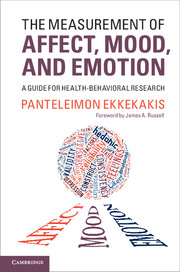Book contents
- Frontmatter
- Contents
- Figures
- Foreword
- Prologue
- 1 Documenting the breadth and depth of the problem
- 2 Untangling the terminological Gordian knot
- 3 Should affective states be considered as distinct entities or as positioned along dimensions?
- 4 Are pleasant and unpleasant states independent or polar opposites?
- 5 Selecting a measure
- 6 The old classics
- 7 Dimensional measures
- 8 Domain-specific measurement
- 9 Problems of domain specificity
- Epilogue
- References
- Index
8 - Domain-specific measurement
Challenges and solutions
Published online by Cambridge University Press: 05 March 2013
- Frontmatter
- Contents
- Figures
- Foreword
- Prologue
- 1 Documenting the breadth and depth of the problem
- 2 Untangling the terminological Gordian knot
- 3 Should affective states be considered as distinct entities or as positioned along dimensions?
- 4 Are pleasant and unpleasant states independent or polar opposites?
- 5 Selecting a measure
- 6 The old classics
- 7 Dimensional measures
- 8 Domain-specific measurement
- 9 Problems of domain specificity
- Epilogue
- References
- Index
Summary
As discussed in Chapter 1, the measurement of affect, mood, and emotion in many areas of health-behavioral research suffers from a number of limitations. Primary among them is a generally unprincipled approach to measurement decisions, leading to such phenomena as the selection of measures without any supporting rationale and the unwarranted interchange of terms and constructs. The consequence of this ongoing problem is the inability to integrate information across studies and, in effect, a slower rate of progress than what might have been possible under different circumstances. Approximately a quarter century ago, Russell (1989) wrote that, given the extent of measurement problems, “it is not surprising that despite years of research, the mood-altering effects of even alcohol cannot be clearly stated” (p. 100). Unfortunately, it would be hard to argue that the situation has improved much since then.
With time, each of the many fields that fall under the broad rubric of health-behavioral research seems to have developed its own unique “quasi-paradigm” with regard to the measurement of affect, mood, and emotion. Although no de facto measurement standards have emerged and diversity of measurement choices remains the norm, there is a discernible tendency in some fields to use certain measures more frequently than others. This is probably an indication that specialized fields of applied research gradually loosen their connection to and lessen their input from affective psychology. Instead, they tend to reproduce arguments, concepts, practices, and measurement decisions that have appeared at least once within those same specialized fields.
- Type
- Chapter
- Information
- The Measurement of Affect, Mood, and EmotionA Guide for Health-Behavioral Research, pp. 138 - 154Publisher: Cambridge University PressPrint publication year: 2013



